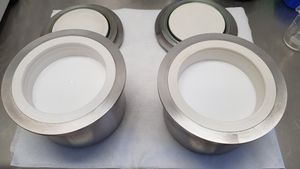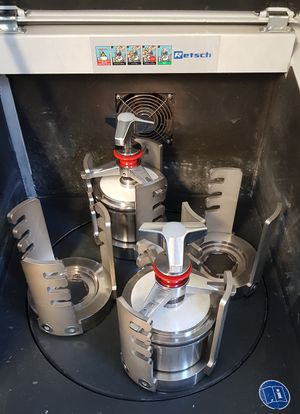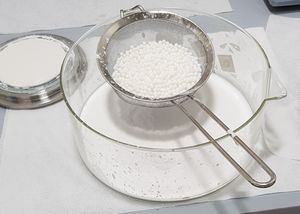Difference between revisions of "Planetary Ball Milling"
(→Selection of the milling media) |
(→Selection of the milling media) |
||
| Line 1: | Line 1: | ||
== General remarks == | == General remarks == | ||
== Selection of the milling media == | == Selection of the milling media == | ||
| + | Milling media refers to the milling balls, the milling jar and the liquid. Typical jar/ball materials are polymer (jar only), glass, alumina, zirconia, and tungsten carbite. | ||
| + | The material of the milling balls and jar should be selected along the following lines: | ||
| + | * Hardness: The balls and jar should be harder then the powder that is to be milled to reduce contamination by wear. | ||
| + | * Chemical compatibility: Some abrasion will occur in any case. If the jar/ball material is compatible with the powder, this is not an issue. | ||
| + | |||
Which balls to use? | Which balls to use? | ||
Material: depending on the powder and the amount of contamination that is acceptable. | Material: depending on the powder and the amount of contamination that is acceptable. | ||
Revision as of 12:16, 10 June 2021
Contents
General remarks
Selection of the milling media
Milling media refers to the milling balls, the milling jar and the liquid. Typical jar/ball materials are polymer (jar only), glass, alumina, zirconia, and tungsten carbite. The material of the milling balls and jar should be selected along the following lines:
- Hardness: The balls and jar should be harder then the powder that is to be milled to reduce contamination by wear.
- Chemical compatibility: Some abrasion will occur in any case. If the jar/ball material is compatible with the powder, this is not an issue.
Which balls to use? Material: depending on the powder and the amount of contamination that is acceptable. Size: depends on the desired final particle size Which jar to use? Volume, Material. How much filling can go in? (Powder, balls, liquid) Which liquid to use? (Water content, possible reactions, solubility of the educts in the liquid, safety) Contaminations
Filling the milling jars
Milling procedure
Separating the slurry
Use a very clean sieve (sieves are a source of contamination) and a wide and clean glass beaker to separate the slurry and balls. The finer the balls are, the more slurry and powder remains in the balls. To a ceratin amount, it can be drained with additional liquid. If the balls are smaller than 2mm, it is best to use a technical sieve with 150µm mesh. Using a funnel and a glas bottle with vacuum adapter all with appropriate sealing will ease the procedure and minimize the amount of solvent needed to separate the slurry.
Drying
The glass beaker is covered with aluminium foil with a number (10-30) holes to allow evaporation of the liquid. The beaker then can be dried in a laboratory oven at a temperature below the boiling temperature of the liquid. Boiling should be prevented as it can cause contamination of the oven. If the liquid is flammable, the drying stove should be explosion protected and the lab well-vented. Drying usually takes at least one day.
Sieving
As after drying, the powder is usually agglomerated, it should be sieved once it is completely dry. Avoid sieving slightly humid powder.


